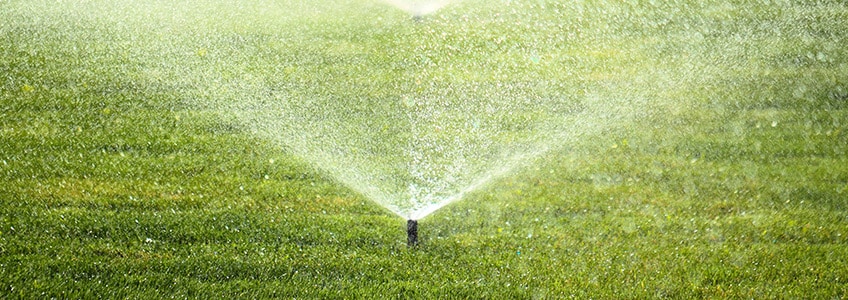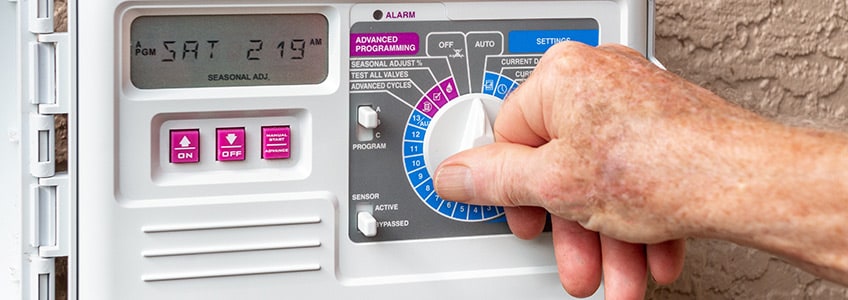
How to Blow Out a Sprinkler System
You may already know that you need to winterize a pump before freezing temperatures arrive each year. But did you know that using an air compressor is one of the easiest ways to winterize sprinklers?
In this article, you'll learn the basics of sprinkler winterization and blowing out your sprinkler system with an air compressor.
The Dangers of Not Winterizing a Water Pump
If any water pump or piping sits above the frost line, all the water in the line is susceptible to freezing, thawing, and potentially cracking the pump, casing, or piping. This is costly to repair, especially with a lawn irrigation system. To minimize the risk of damage, a water pump system must be adequately winterized to remove excess water and moisture from the lines before freezing can occur.
To put this in perspective, a small leak in a sprinkler line can add hundreds of dollars to your water bill in a single month. The best way to prevent this is to properly protect your water lines by blowing them out every season before winter. A badly damaged sprinkler system may need to be replaced and reinstalled, which carries a price tag in the thousands of dollars.
Ways to Winterize an Irrigation System
There are generally three methods used to winterize a pump system: manual drain, auto-drain, and the blowout method (air compressor). The blowout method is usually the easiest and most efficient way to winterize a sprinkler pump system.

Recommendations for Blowing Out an Irrigation System
Blowing out a sprinkler system can be dangerous, and all necessary safety precautions must be taken, including:
- Eye protection should be worn at all times.
- Never allow yourself or anyone else to stand above the pipes, sprinklers, or any valves.
- Ensure you have the proper equipment necessary to do the job correctly.
- Air pressure (PSI) and volume (CFM) must be controlled at all times.
- Never blow air into a closed line or valve.
- Never overdo a blowout - the heat and friction can damage the lines if the air pressure doesn't crack them first.
Portable, household air compressors will not have nearly enough power to blow out an irrigation system. Never try to fill a compressor tank fully and then release it all at once to compensate for a lack of air volume. The trick is to have lower pressure (PSI) and higher air volume (CFM) to evenly and safely eject water and vapor from the water lines.
A good rule of thumb is that the air compressor needs to be able to sustain the recommended PSI and CFM requirements (read below) for at least 2 minutes per zone on a sprinkler system to be effective. The bigger tank your compressor has, the less time you'll be waiting for it to refill during a blowout, referred to as a duty cycle.
How Much Pressure Do I Need to Blow Out Water Lines?
The recommended PSI ratings for blowouts are not to exceed 50 PSI for general safety and efficiency. Never exceed this PSI when the system is using PVC piping, or you can crack the pipes. If nothing else, absolutely do not run any compressor higher than 80 PSI in your lines, or damage will be more than likely to occur.
How Big of a Compressor is Needed to Blow Out Sprinklers?
The minimum volume an air compressor needs to properly blow out an irrigation system is 20 cubic feet per meter (CFM). Still, many professionals recommend up to 50 CFM at under 50 PSI for optimal performance, assuming the water lines are less than an inch in diameter. The larger the pipe, the higher CFM (volume) it will take to do the job as well.
Read our guide on how to size a sprinkler system if you are building one for the first time or would like more information about sprinkler pumps.

How to Blow Out Sprinkler Systems
Using an air compressor with the recommended PSI and CFM ratings (50 PSI and 20-50 CFM), the steps below outline the general process of blowing out water lines on an irrigation system. Always read your owner's manual for recommendations on proper use and safety before attempting the blowout. Consult an irrigation professional or seek additional help if needed. We also recommended that you blow out your sprinkler system one zone at a time.
Step 1 - Prepare the Lines
The first step is to turn off the irrigation lines and ensure no more water is able to flow into the lines. During this step, make sure the pressure sensors on an irrigation system are disconnected and protected so they won't be damaged during the spray. Close the backflow preventer isolation valves to ensure no air can enter. Remember, whichever zone you are working in first, make sure those valves are opened fully to prevent damage to the closing components.
Step 2 - Connect the Air Compressor to the Blow Out Port
Every system should have a blowout port built into the piping. It is generally best practice to start the blowout process with the zone furthest away from the compressor hookup, using valves to control the airflow. Do not connect your air hose to the test cocks or any connection before the backflow preventer. Always make connections after the backflow valves in the line. Running air through the backflow preventer can significantly damage it, which is also expensive to replace.
Step 3 - Blow Out Sprinklers
Make sure the valves are open on the zone you are blowing out. A closed line with pressurized air running through it can burst the pipe. Turn on the compressor and begin the blowout process. Some people prefer blowing out a zone in multiple segments instead of one long blowout. Once the water does not appear to be exiting the sprinklers, turn off the air supply to the line, as dry air going through those pipes may create friction and general wear and tear. Repeat this process for every zone, repeating zones if necessary.
Step 4 - Drain the Backflow Preventer
After the blowout is complete and all lines have been cleared, it's time to release the water and pressure in the backflow preventer. Open the remaining test cocks and ball valves and allow water to drain. Once everything is emptied fully, some professionals will leave the valves open at 45 degrees to let any water that may enter the pipe during the season out so it won't freeze in the line.
Recommended Air Compressors For Winterizing Sprinklers
Some experts recommend using gasoline-powered air compressors because of their portability and lack of electrical reliance, which can potentially be dangerous to use while blowing out water lines.
Either way, for businesses and professionals, we recommend air compressors that can provide 20+ CFM at 50 PSI and consistently hold those values for at least 5 minutes at a time during use. Whether this is a gas, electric, stationary, or portable compressor is up to you to decide.
Homeowners can get away with less air power for their homes. We recommend the Rolair VT25BIG air compressor, especially if you only have 115-volt electrical access.
Sprinkler Blowout FAQs
How much does it cost to have sprinklers blown out?
The cost will depend on the company, quote, and services. Generally, it will cost somewhere between $50 - $200 depending on how many sprinkler zones your irrigation system has. The only way to know the average price in your area is to call around and ask for quotes. If you don't own an air compressor that can handle a proper sprinkler blowout, this is a much cheaper option for professional results.
When is the best time to blow out a sprinkler system?
Generally, this answer comes down to a cross between timing and luck. It first depends on where you live, regionally, and how cold seasons affect your areas. If you wait too long, you risk early freezes causing damage to your system. For example, if you live in the northern United States, generally early October is the best time to winterize your irrigation system and blow out the water lines.
What attachments do I need to attach my air compressor to the sprinkler system?
There are multiple methods for doing this, and a few professionals have shared some handy DIY methods of doing so. The most popular way is to take a washer hose and cut one end off to attach a quick-connect air compressor tip to the open end of the hose using a hose clamp. This method is inexpensive and typically works well for making the proper connection. There are adapters sold specifically to make this connection as well.


![Top 7 Best Portable Air Compressors of 2025 [Expert-Picked]](https://www.aircompressorsdirect.com/article-image/334/social_img_662.jpg)


